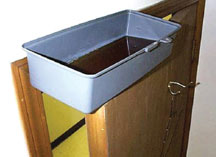
Law Enforcement
A proposed new ASTM International standard for liquid threats to protective clothing will cover the specific needs of law enforcement officers. The new standard, WK25965, Test Method for Liquid Threat Sprayed on a Mannequin, is being developed by Subcommittee F23.30 on Chemicals, part of ASTM International Committee F23 on Personal Protective Clothing and Equipment.
Fire and hazardous materials personnel can encounter chemical, biological, radiological and nuclear situations that require them to be in a heavy liquid environment for extended periods of time. Protective clothing worn in these situations can be tested to ASTM standard F1359, Test Method for Liquid Penetration Resistance of Protective Clothing or Protective Ensembles Under a Shower Spray While on a Mannequin.
However, Thomas M. Nolan, a lieutenant in the Upper Merion Township Police Department, King of Prussia, Pa., notes that the role of a law enforcement officer at a CBRN event would be different from those working in the fire or hazardous materials areas, which means that a different kind of uniform protection would be needed.
Law enforcement officials are not expected to mitigate leaks or spills that could cause them to be in an environment that would require their ensembles to resist liquid penetration to a level as intended in F1359.
"Law enforcement's role at a CBRN event is limited to neutralizing an adversarial threat in or near a CBRN environment," says Nolan, who is a member of both F23 and Committee E54 on Homeland Security Applications and co-chairs the joint F23/E54 Task Group on Law Enforcement Personal Protective Equipment Standards. "This exposure to a liquid threat should be a limited duration."
According to Nolan, it is generally believed that the greatest liquid threat that law enforcement officials face would be from an adversary throwing a bucket of liquid on them or from a bucket positioned above that would spill on them in a room entry situation.
"An ensemble with too much liquid penetration resistance protection could have an adverse effect on the officer trying to perform a law enforcement mission," says Nolan. "This adverse effect could be added weight or noise or heat stress. By limiting the level of liquid penetration resistance needed for a law enforcement ensemble, we can ensure that we are not over-engineering with a level of protection that is not needed."
Interested parties are invited to participate in the standards development activities of Committee F23.
CONTACT Technical Information: Thomas M. Nolan, Upper Merion Township Police Department • King of Prussia, Pa. • Phone: 610-205-8549 • E-mail: tnolan@umtownship.org O ASTM Staff: Stephen Mawn • Phone: 610-832-9726 • E-mail: smawn@astm.org O Upcoming Meeting: June 8-10 • June Committee Week • St. Louis, Mo.
 SN Home
SN Home Archive
Archive Advertisers
Advertisers Masthead
Masthead RateCard
RateCard Subscribe
Subscribe Email Editor
Email Editor